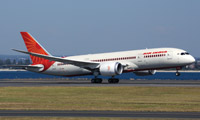News Backgrounder
Rapid response
The mystifying disappearance of Malaysia Airlines flight MH 370 has added urgency to calls to introduce technology that will ensure a big jet will never again vanish from the skies.
June 1st 2014
Real time tracking of commercial aircraft will soon be a standard operating practice at many airlines following developments at a meeting of the government council of the International Civil Aviation Organisation in Montreal in May. Read More »
ICAO said several airlines already had decided to voluntarily improve the tracking of their airliners while the United Nations agency went about the more extended process of establishing a new standard for worldwide commercial aircraft tracking.
 |
| Kevin Hiatt, IATA’s senior vice president for safety and flight operations: the taskforce would offer ICAO guidelines as it develops binding standards |
Director of ICAO’s Air Navigation Bureau, Nancy Graham, said: “the process of consultation is long, but it’s important. The announcement came five weeks after the International Air Transport Association (IATA) established a taskforce that has been asked to come up with a better system for tracking by September.
Kevin Hiatt, IATA’s senior vice president for safety and flight operations said the taskforce would offer ICAO guidelines as it develops binding standards.
Since Malaysia Airlines flight MH 370 vanished from radar screens, after taking off from Kuala Lumpur early on March 8, some national aviation authorities have tightened rules for commercial airline tracking in their own airspace.
India’s Directorate General of Civil Aviation (DGCA) has instructed the country’s airlines to track all aircraft in real time. The directives will apply to both passenger and cargo aircraft. In Europe, the European Aviation Safety Agency (EASA) has drawn up proposals to make it easier to locate black boxes from missing aircraft and the U.S. National Transportation Safety Board (NTSB) said it is studying the possibility of live-streaming flight data recorders.
Last month at the conference, “Expert Dialogue on Real-time Monitoring of Flight Data, including the Black Box – the need for international Standards in the Age of Cloud Computing and Big Data” organized by the Malaysian government, the country’s Minister for Communications and Multimedia, Ahmad Shabery Cheek, said the difficulties surrounding the search for MH 370 highlighted the need for information and communication technologies (ICT) that are instrumental to the safe and efficient operation of tens of thousands of flights each day.
Delegates at the invitation only conference included representatives from ICT solution providers, airlines, international organizations, satellite and avionics companies, terrestrial solution providers and governments who will co-ordinate a stakeholder-wide system for real time tracking of flight data.
| Inmarsat takes lead Andrew Sukawaty, chairman of communications provider Inmarsat, has announced the satellite company will offer commercial airlines free satellite tracking services for their aircraft to avoid future losses of airliners. Inmarsat plans for airlines to be incorporated into a future global satellite tracking system for their aircraft, which currently mainly use ground-based radar for monitoring airliners en route from departure to destination. It is understood Inmarsat will pay to upgrade the global airline network to support the tracking service. The airlines are to be asked to invest in additional equipment and installation costs to upgrade the tracking system. |
In Europe, the EASA would bring into force some recommendations put forward by France after the loss of an Air France jet in the South Atlantic Ocean in 2009. They were never implemented. The main proposal was a new pinger frequency that would make it easier to locate recording devices under water.
Another major recommendation was an increase in the minimum amount of recording time available on cockpit voice recorders so accident analysts could more accurately investigate cockpit activity before and during an accident.
MAS flight MH370, still believed to be at the bottom of the Indian Ocean off the West Australian coast, is believed to have flown for seven hours after it went missing on March 8, meaning the standard two-hour cockpit voice recording loop would not cover conversations during the crucial early stages of the flight.
 |
| India’s aviation regulator demands all Indian commercial and cargo airplanes be tracked in real time |
Separately, the U.S. NTSB said it is studying the possibility of live-streaming of flight data recorders. NTSB director of research and engineering for the board, Joe Kolly, said NTSB officials, other national safety investigation bodies, the ICAO, equipment manufacturers and airlines were looking developing a system that could stream a limited amount of flight data.
Governments are also interested in the possibility of streaming flight data to ensure security. “We have our staff involved in technical meetings and working groups about the category of data needed, the rates at which those data is needed to be transmitted and also what would trigger the data download, Kolly said.
In India, the DGCA pointed out that while commercial aircraft spend a considerable amount of time operating over remote areas, there is no international requirement for real time tracking of the aircraft.
It has ordered Indian carriers to track aircraft in real time using the onboard Aircraft Communications Addressing and Reporting System (ACARS) or Automatic Dependent Surveillance – Broadcast (ADS-B). The DGCA has required the country’s airlines to devise a procedure to track aircraft flying over areas not covered by ACARS or ADS-B and said flight crews must report aircraft coordinates, speed and altitude every 15 minutes while flying over such spaces.
The regulator said airlines should monitor faults and warning messages of ACARS and that flight crews must immediately report any issue with ACARS or ADS-B to ground stations via voice or data link. The DGCA will monitor the effectiveness of the directives during surveillance inspections.
| ACTION PLAN * Several airlines implement immediate voluntary global tracking of their aircraft fleets * International Air Transport Association instructs special taskforce to prepare a best practice set of recommendations for a global commercial aircraft tracking system by September this year * The International Civil Aviation Organisation and its industry stakeholders agree to develop an industry standard for global tracking of commercial airline fleets * The National Transportation Safety Board, airlines, manufacturers and regulators consider the technology and regulations required for the introduction of live data streaming from the cockpit to ground bases. |